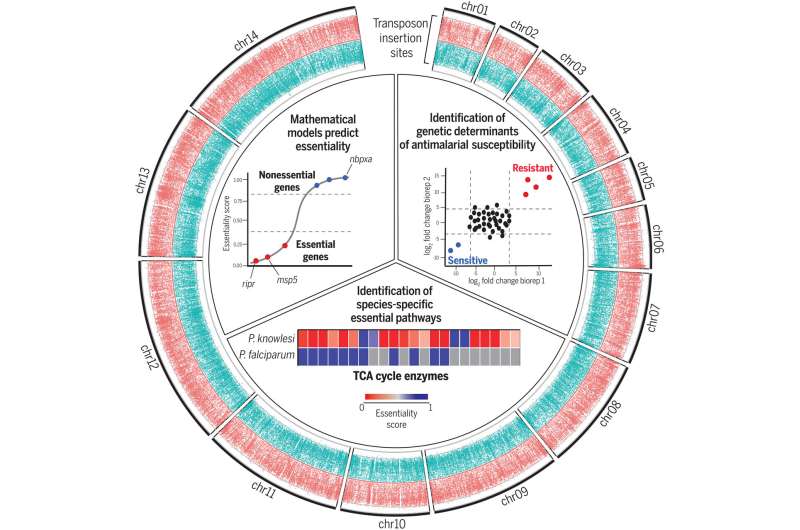This article has been reviewed according to Science X's editorial process and policies. Editors have highlighted the following attributes while ensuring the content's credibility:
fact-checked
peer-reviewed publication
trusted source
proofread
Essential gene map of malaria parasite Plasmodium knowlesi aids in treatment design

A new, comprehensive map of all the genes essential for blood infections in Plasmodium knowlesi (P. knowlesi), a parasite that causes malaria in humans, has been generated by researchers at Harvard T.H. Chan School of Public Health and colleagues. The map contains the most complete classification of essential genes in any Plasmodium species and can be used to identify druggable parasite targets and mechanisms of drug resistance that can inform the development of new treatments for malaria.
"We hope that our findings are a major step for the field of malaria research and control," said co-corresponding author Manoj Duraisingh, John LaPorte Given Professor of Immunology and Infectious Diseases. "Emerging drug resistance to the small number of antimalarial drugs is a growing problem. This map will be an invaluable resource to help researchers combat one of the leading causes of infectious disease death around the world."
The study is published in Science.
Each year, around 249 million human cases of malaria are caused by a Plasmodium species, resulting in about 608,000 deaths. P. knowlesi is one of several species responsible for human malaria. It is a zoonotic parasite that can be lethal and is an emerging public health problem in Southeast Asia.
The researchers developed a powerful genetic approach in P. knowlesi, known as transposon mutagenesis, to disrupt all of the genes not needed for growth in human red blood cells, thus revealing a map of all of those remaining that were essential for growth. This identified at a genomic scale the molecular requirements for parasites to grow. The researchers were also able to pinpoint specific genes that cause resistance to current antimalarials.
"Knowing all of the essential genes in P. knowlesi allows us to understand the molecular strategies that the parasite takes to grow, to respond to environmental changes, and to respond to therapeutics such as antimalarials," said co-first author Sheena Dass, postdoctoral fellow in the Department of Immunology and Infectious Diseases. "This molecular blueprint will help malaria researchers in the design and execution of biological studies of malaria as well as inform strategies to monitor and limit the emergence of drug resistance."
The researchers noted that the findings also provide insights into one other malaria-causing Plasmodium species, P. vivax, due to their evolutionary relatedness. P. vivax, which is poorly studied because it is not culturable or genetically tractable, is a major challenge to elimination efforts.
Brendan Elsworth and Sida Ye were co-first authors. Co-corresponding author was Kourosh Zarringhalam at the University of Massachusetts, Boston. Other Harvard Chan co-authors included Jacob Tennessen, Basil Thommen, Aditya Paul, Usheer Kanjee, and Christof Grüring.
More information: Brendan Elsworth et al, The essential genome of Plasmodium knowlesi reveals determinants of antimalarial susceptibility, Science (2025). DOI: 10.1126/science.adq6241
Journal information: Science
Provided by Harvard T.H. Chan School of Public Health

















